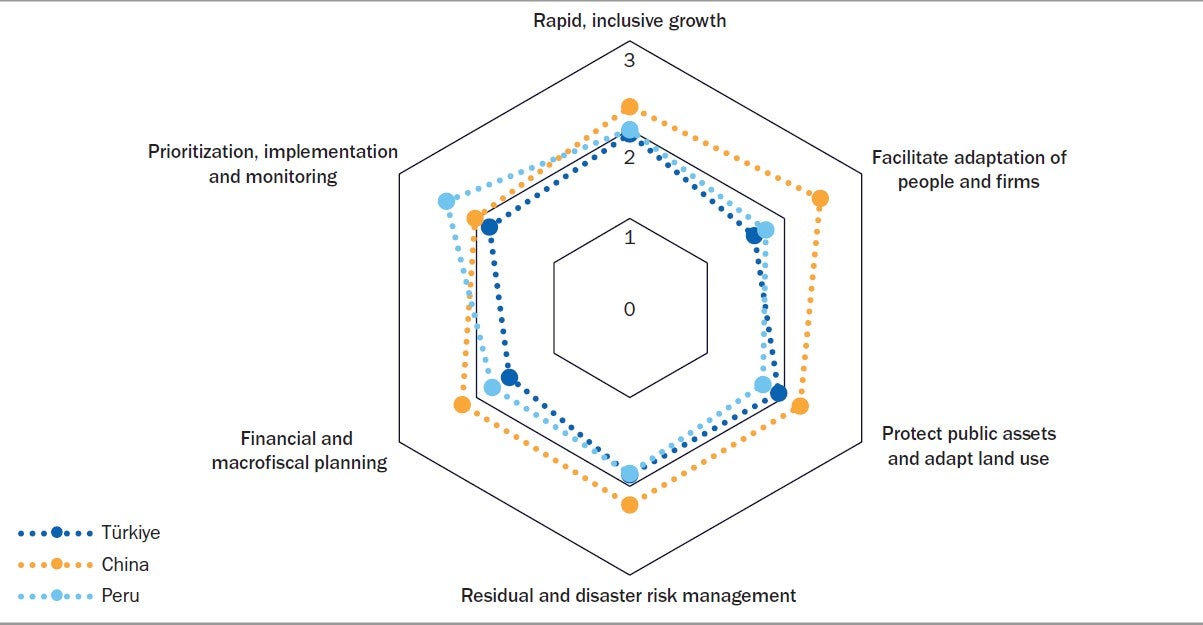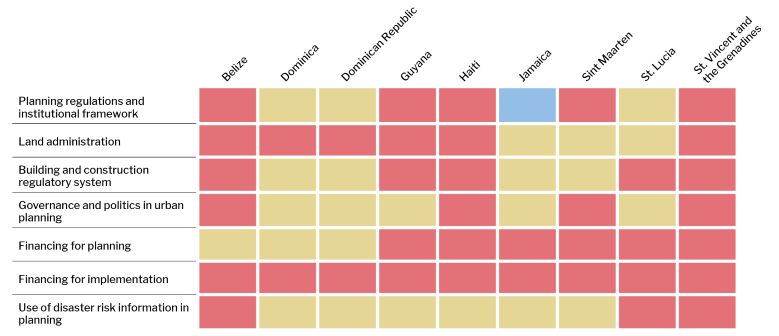 Rebuilding roads in Dominica after Hurricane Maria
Rebuilding roads in Dominica after Hurricane Maria
After Category-5 Hurricane Maria devastated Dominica in 2017, the Caribbean-island country took steps to increase its resilience to climate-related events. It established the Climate Resilience Execution Agency for Dominica (CREAD) to set clear objectives and measurable targets, and to coordinate strategic initiatives across all sectors of the economy – from building resilience with climate-resilient homes and infrastructure, to more sustainable farming and fishing practices, robust planning, budget allocation and governance.
Dominica’s whole-of-economy approach is a good example of what countries need to put in place to address future climate change impacts. Sudden events like flooding or tropical cyclones, along with long-term trends like temperature increases, are acting as threat multipliers to existing vulnerability, exacerbating poverty and fragility and reversing decades of development gains. In response, countries need to develop comprehensive climate change adaptation strategies, identify short-term priorities, set targets, and monitor progress.
6 pillars of climate change adaptation
- Building resilient foundations through rapid and inclusive development
- Facilitating the adaptation of firms and people
- Adapting land use and protecting critical public assets and services
- Increasing people’s capacity to cope with and recover from shocks
- Anticipating and managing macroeconomic and fiscal risks
- Ensuring effective implementation with a robust governance structure and continuous monitoring
The detailed assessment evaluates each pillar and a set of action areas using a mix of quantitative and qualitative indicators to assess achievement, progress, and gaps in order to identify priority areas for intervention.
Applying the tool to different countries
The scoring system was first developed in the Caribbean for a comprehensive assessment, 360° Resilience, producing detailed risk profiles and score cards of progress towards climate change adaptation and resilience for 17 Caribbean countries. More recently, the tool was further developed and applied in the new World Bank Country Climate and Development Reports (CCDRs), including in Türkiye, Peru and China. Emerging insights in a new CCDR report, Climate and Development: An Agenda for Action, show that these countries are all making progress in key areas, but progress is uneven (Figure 1). For example, China performs well with socioeconomic development and the enabling environment to support people and firms to adapt. However, more can be done to strengthen the legal framework and governance for adaptation and resilience, social protection of the poorest, biodiversity protection and nature-based solutions. Peru has made progress on legal frameworks to support implementation, coordination, monitoring and evaluation of adaptation. Peru, however, could make greater efforts to integrate implementation across national and local governments, protect critical public services, such as water and health, improve land use planning, strengthen disaster risk management, and develop the insurance sector. Türkiye has made significant efforts to build adaptive capacity in key sectors, but could benefit from greater social inclusion, women’s empowerment, and an enhanced governance structure to enable effective adaptation by households, communities and the private sector. Further, the assessments show that all countries need to do more to mainstream climate and disaster risk considerations by the private sector and in financial and macro fiscal planning.
Figure 1. Adaptation and resilience readiness of China, Peru and Türkiye

Note: For each pillar, a set of indicators is assessed with a score between 1 to 3 (1=nascent, 2=emerging, and 3=established) for each indicator. Aggregating the scores (with equal weight) gives the score for each pillar
Source: World Bank Group. 2022. Climate and Development : An Agenda for Action - Emerging Insights from World Bank Group 2021-22 Country Climate and Development Reports. Washington, DC: World Bank. © World Bank Group. https://openknowledge.worldbank.org/handle/10986/38220 (Figure 4 in the report)
Results from the Caribbean
Similarly, the detailed assessment for 17 Caribbean countries found that all countries are making progress in different areas of resilience, but they are not prepared for new challenges posed by climate change. For example, sea level rise is expected to increase coastal flooding and accelerate erosion, which is a threat for tourism-dependent economies and settlements that tend to be concentrated along the coast. Under a high climate change scenario, a 35-meter shoreline retreat of sandy beaches is projected by 2050 across all Caribbean countries. In the absence of planning and adaptation responses—such as protecting vulnerable areas with green and gray infrastructure or a planned retreat – by 2050, countries like Antigua and Barbuda, Trinidad and Tobago, and the Bahamas will see a large proportion of their hotels unable to profit from the proximity of a sandy beach.
Building codes and land use regulations are remarkably powerful and cost-effective to protect infrastructure and people’s safety in the face of climate change and disaster risks. However, assessment of land use and urban planning in the Caribbean found that in many countries, codes and regulations often are not enforced or adapted to the local context.; they also often do not consider how the poorest can afford resilient building and fail to address high levels of informal settlement (Figure 2). Developing up-to-date current and future climate risk information at the decision-relevant scale (especially at the local level) and making it publicly available can go a long way to support governments, people and businesses to make resilient decisions.
Figure 2: Land use and urban planning scores in Caribbean countries

Note: Countries in red do not meet the standard, in yellow partly meet the standard, in blue meet the standard completely.
Source: Rozenberg, Julie; Browne, Nyanya; De Vries Robbé, Sophie; Kappes, Melanie; Lee, Woori; Prasad, Abha. 2021. 360° Resilience : A Guide to Prepare the Caribbean for a New Generation of Shocks. World Bank, Washington, DC. © World Bank. https://openknowledge.worldbank.org/handle/10986/36405 (Table 9.3)
Moving forward on adaptation
As the impacts of climate change intensify, there is no time to waste to move forward on adaptation in countries where this is a priority . This tool can help countries establish baselines, identify gaps, prioritize actions, and monitor progress towards making adaptation an integral part of development strategies. The result-based indicators provide a robust foundation to connect the assessment to action and to monitor and evaluate progress. The consistent approach can also support global stocktaking to track progress towards adaptation goals of the Paris Agreement. Going forward, the tool can be further enhanced and used to serve countries and the international community by incorporating robust global data and local knowledge on policy and institutional development, working closely with country and sectoral experts.
For more information on the adaptation diagnostic tool, please email Jia Li.




Join the Conversation